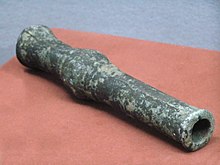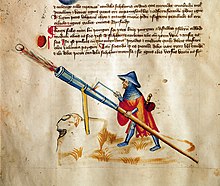Hand cannon: Difference between revisions
m gen fixes: (1) apply Template:Lang (1), using AWB |
|||
| Line 31: | Line 31: | ||
Firearms, of which the hand cannon was an early example gradually came to dominate European [[war]]fare, and the reasons are clear. The hand cannon was inexpensive and easy to mass produce. At the same time, the forging methods required meant that centralized governments had a measure of control over their manufacture (and especially the manufacture of ammunition - an important consideration in a medieval Europe wracked by rebellion). They had superior armor-penetration capability; the [[longbow]] was somewhat effective against [[mail armor]], and the [[crossbow]] slightly better, but the hand cannon could pierce even [[plate armor]]. Furthermore, much like the crossbow, the weapon could be employed by relatively poorly-trained troops. |
Firearms, of which the hand cannon was an early example gradually came to dominate European [[war]]fare, and the reasons are clear. The hand cannon was inexpensive and easy to mass produce. At the same time, the forging methods required meant that centralized governments had a measure of control over their manufacture (and especially the manufacture of ammunition - an important consideration in a medieval Europe wracked by rebellion). They had superior armor-penetration capability; the [[longbow]] was somewhat effective against [[mail armor]], and the [[crossbow]] slightly better, but the hand cannon could pierce even [[plate armor]]. Furthermore, much like the crossbow, the weapon could be employed by relatively poorly-trained troops. |
||
The other hand-operated ranged weapons of the time had their own drawbacks. [[Crossbows]] had superior accuracy and similar power as compared to early hand cannons. However they were expensive to make, slow to reload and their performance was almost as severely affected by wet weather as that of hand cannons. While the hand cannon could not match the accuracy nor speed of fire of the [[longbow]], gunners did not require the special training and continuous practice from childhood required of a good bowman. |
The other hand-operated ranged weapons of the time had their own drawbacks. [[Crossbows]] had superior accuracy and similar power as compared to early hand cannons. However, they were expensive to make, slow to reload and their performance was almost as severely affected by wet weather as that of hand cannons. While the hand cannon could not match the accuracy nor speed of fire of the [[longbow]], gunners did not require the special training and continuous practice from childhood required of a good bowman. |
||
Despite the hand cannon's serious drawbacks, especially early in its development, its virtues outshone those of either the longbow or the crossbow, and it grew and evolved to become the ubiquitous firearm of later European wars. |
Despite the hand cannon's serious drawbacks, especially early in its development, its virtues outshone those of either the longbow or the crossbow, and it grew and evolved to become the ubiquitous firearm of later European wars. |
||
Revision as of 20:06, 23 November 2008
This article may be in need of reorganization to comply with Wikipedia's layout guidelines. (July 2007) |




The hand cannon (Arabic: midfa; Chinese: 手銃), as it was called, was the first handheld portable firearm, or handgun.
Early firearms ranging from hand cannons to arquebuses are referred to in texts of the period by many spellings: gonne, gunne, canon being a few examples.
History
The hand cannon was used until at least the 1520s in Europe and the Middle East, and until modern times in the Far East.
However, where it was invented remains an area of controversy. The Arabs, Chinese and Mongols all have a claim, as do the Europeans to a lesser extent.
Al-Hassan claims that the Battle of Ain Jalut in 1260 saw the Mamluks use against the Mongols in "the first cannon in history" gunpowder formulae which were almost identical with the ideal composition for explosive gunpowder.[1][2] However, Khan states that it was invading Mongols who introduced gunpowder to the Islamic world[3] and cites Mamluk antagonism towards early riflemen in their infantry as an example of how gunpowder weapons were not always met with open acceptance in the Middle East.[4]
According to Chase (2003:1),
There was once a great deal of confusion and controversy surrounding the invention of firearms, but it is now generally accepted that firearms originated in China. Although there is no solid evidence for firearms in Europe before the 1300s, archeologists have discovered a gun in Manchuria dating from the 1200s, and an historian has identified a sculpture in Sichuan dating from the 1100s that appears to represent a figure with a firearm. Since all the other evidence points to Chinese origins, it is safe to conclude that this was in fact the case.
The Europeans certainly had firearms by the first half of the 1300s. The Arabs obtained firearms in the 1300s too, and the Turks, Iranians, and Indians all got them no later than the 1400s, in each case directly or indirectly from the Europeans. The Koreans adopted firearms from the Chinese in the 1300s, but the Japanese did not acquire them until the 1500s, and then from the Portuguese rather than the Chinese.
Design and Features
The hand cannon was a simple weapon, mostly effective in sieges and ambushes. It was less effective in open battle and in wet or windy conditions. Despite its crude appearance, the hand cannon could kill even heavily armoured opponents at short ranges - if the gunner could manage to hit them. Experiments indicate an effective range of about 50 metres and a maximum range of about 300 metres, depending on calibre and type of powder used.
Hand cannons ranged in barrel length from 190 to 600 mm and from 12 to 36 mm in calibre. Approximate weights ranged from 1.5 kg to a monstrous 15 kg for some siege models. Barrels were typically short compared to later firearms and made from wrought iron or cast in bronze. For ease of handling, the barrels were often attached to a wooden stock. This was done in two ways: either by resting the barrel in a groove in the stock and securing it with metal bands, or by inserting the stock into a socket formed in the rear part of the barrel. Some guns merely had a metal rod formed as an extension to the rear of the barrel as a handle. For firing, the hand cannon could be held in two hands while an assistant applied ignition (such as hot coals or burning tinder) to the touch hole, or propped against something and set off by the gunner himself. Illustrations depict gunners holding the stock in the armpit, or over the shoulder like a modern bazooka to aim their weapon. During sieges, hand cannon were rested on the edges of walls, over the sides of armoured carts, or on forked rests hammered into the ground. Hooks are often found attached to the bottom of the barrel to support the gun against stationary objects or to reduce the recoil.
Later hand cannons were made with a flash pan attached to the barrel, and a touch hole drilled through the side wall of the gun instead of the top of the barrel. The flash pan had a leather cover, and later on a hinged metal lid fitted, to keep the priming powder dry until the moment of firing and to prevent premature firing. The invention of corned powder, the slow match, and the flash pan around 1400 led to the widespread adoption of guns, as those who used them were now no longer required to mix their powder on the spot, to stay close to a source of fire, or to avoid exposure to bad weather.
Cultural Impact
Firearms, of which the hand cannon was an early example gradually came to dominate European warfare, and the reasons are clear. The hand cannon was inexpensive and easy to mass produce. At the same time, the forging methods required meant that centralized governments had a measure of control over their manufacture (and especially the manufacture of ammunition - an important consideration in a medieval Europe wracked by rebellion). They had superior armor-penetration capability; the longbow was somewhat effective against mail armor, and the crossbow slightly better, but the hand cannon could pierce even plate armor. Furthermore, much like the crossbow, the weapon could be employed by relatively poorly-trained troops.
The other hand-operated ranged weapons of the time had their own drawbacks. Crossbows had superior accuracy and similar power as compared to early hand cannons. However, they were expensive to make, slow to reload and their performance was almost as severely affected by wet weather as that of hand cannons. While the hand cannon could not match the accuracy nor speed of fire of the longbow, gunners did not require the special training and continuous practice from childhood required of a good bowman.
Despite the hand cannon's serious drawbacks, especially early in its development, its virtues outshone those of either the longbow or the crossbow, and it grew and evolved to become the ubiquitous firearm of later European wars.
Modern usage
"Hand cannon" is also a slang word which can be used to refer to a modern firearm of significant power but small size. Large caliber pistols, shortened or "sawed off" rifles and shotguns may sometimes be referred to as "hand cannons," though the weapon in question need not be unusual or exotic. The term may also simply refer to any hand-held firearm found to be large or powerful, as a hyperbole term.
References
- Chase, Kenneth (2003), Firearms: A Global History to 1700, Cambridge University Press.
- ^ Ahmad Y Hassan, Gunpowder Composition for Rockets and Cannon in Arabic Military Treatises In Thirteenth and Fourteenth Centuries
- ^ Ahmad Y Hassan, Technology Transfer in the Chemical Industries
- ^ Khan, Iqtidar Alam (1996), "Coming of Gunpowder to the Islamic World and North India: Spotlight on the Role of the Mongols", Journal of Asian History, 30: 41–5.
- ^ Khan, Iqtidar Alam (2004), Gunpowder and Firearms: Warfare in Medieval India, Oxford University Press.
